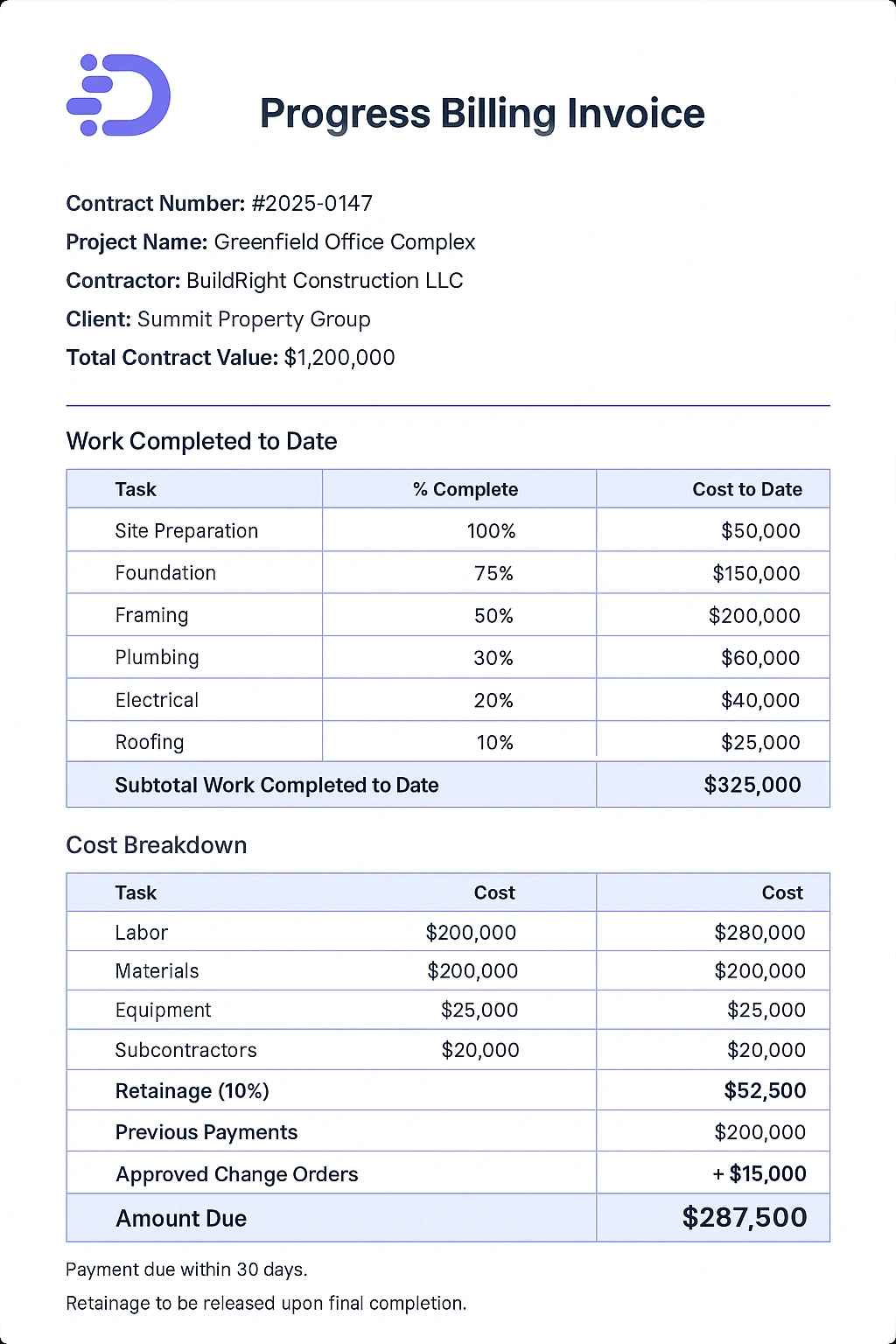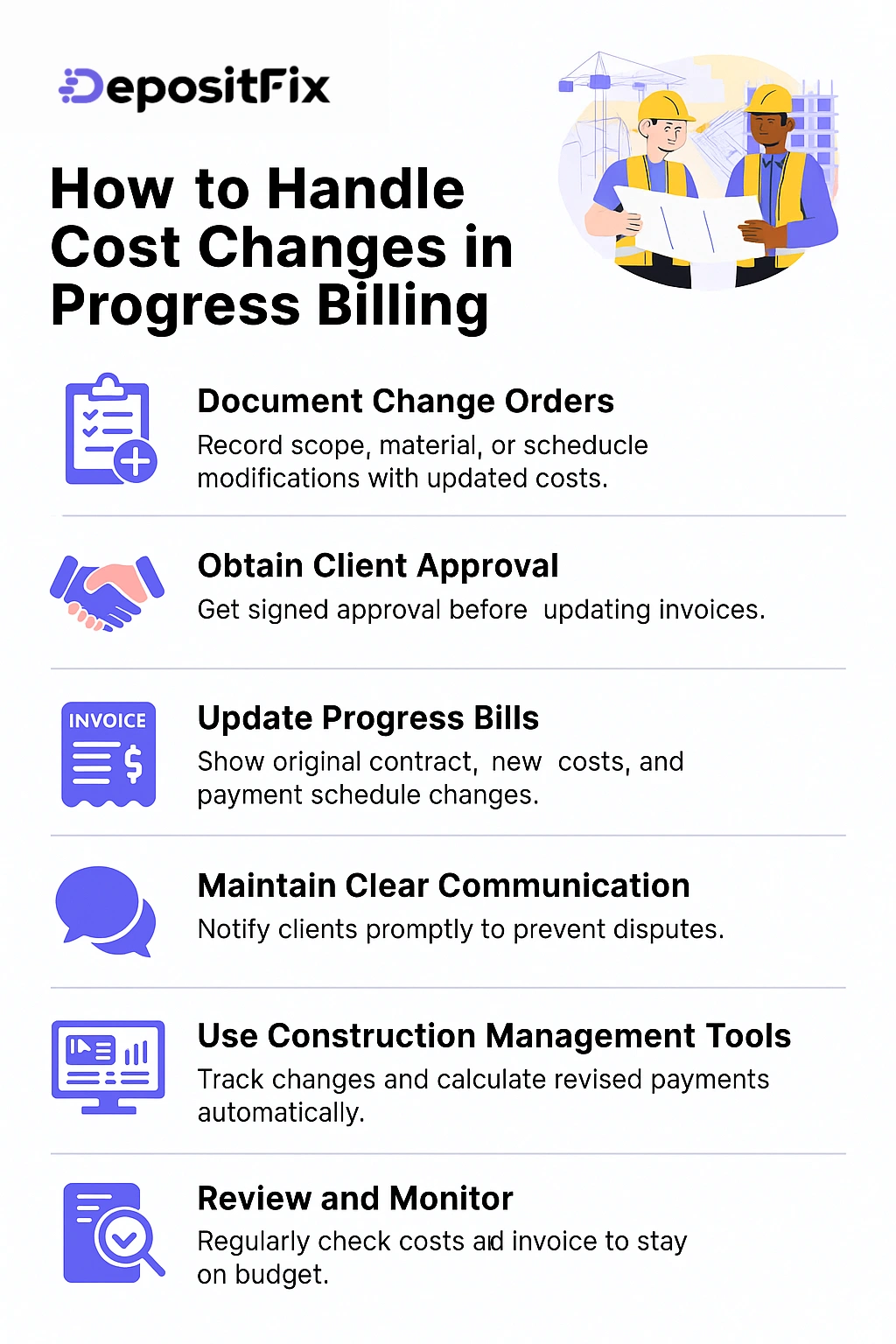Progress billing is a common payment method in the construction industry that allows contractors to receive payments incrementally as work is completed, rather than waiting until the entire project is finished.
This approach helps improve cash flow, ensures that contractors are compensated for ongoing work, and provides clients with a clear breakdown of costs tied to specific project milestones. Typically, progress billing is structured around agreed-upon stages, such as completion of foundation, framing, or roofing, with invoices issued after each stage.
For example, a contractor building a residential home might submit an invoice for 25% of the total project cost once the foundation is completed, another 30% after framing, and the remaining balance upon final completion.
This system keeps both parties aligned, reduces financial risk, and promotes transparency throughout the construction process.
Progress billing is a method of invoicing commonly used in the construction industry that allows contractors to request partial payments for work completed at various stages of a project, rather than waiting until the entire project is finished.
Unlike traditional lump-sum billing, progress billing breaks down the total contract amount into smaller, manageable payments tied to specific milestones or phases of the project. This approach benefits both contractors and clients: contractors maintain steady cash flow to cover labor, materials, and other expenses, while clients gain a clear view of project costs and can verify that work is completed to their satisfaction before making payments.
Progress billing typically involves creating detailed invoices that specify the percentage of work completed, the corresponding amount due, and any retainage withheld for quality assurance. For example, in a commercial building project, a contractor might issue a progress bill for 20% of the total contract after site preparation, 30% after structural framing, 25% after roofing and exterior work, and the remaining balance upon project completion.
This structured payment process reduces financial risk, improves accountability, and fosters a transparent, professional relationship between all parties involved.
Progress billing for construction involves a detailed breakdown of the work completed, costs incurred, and payments due at each stage of a project. Each progress bill serves as a transparent record of both the contractor’s and client’s obligations, helping to ensure accurate payments, reduce disputes, and maintain steady cash flow throughout the construction process.
A comprehensive progress bill typically includes:
This section outlines the basic project information, including the contract number, project name, client and contractor details, and the total contract amount. It serves as the reference point for calculating percentages and payments due at each stage.
Here, the contractor lists all tasks, phases, or milestones completed since the last invoice. This may include site preparation, foundation work, framing, plumbing, electrical, roofing, or other specific construction activities. Each item is typically accompanied by a percentage of completion or quantity completed.
This part details the costs associated with the completed work, including labor, materials, equipment usage, and subcontractor expenses. It ensures that clients understand exactly what they are paying for and how the billed amount was calculated.
Many construction contracts include a retainage amount, typically a small percentage of each payment held back until final completion, to ensure quality and encourage contractors to address any outstanding issues. Progress bills usually indicate the retainage withheld from the current payment.
To maintain accurate financial tracking, the invoice also references any previous progress payments and applies adjustments for changes in scope, approved change orders, or corrections from prior bills.
Finally, the progress bill specifies the total amount currently due after accounting for retainage, prior payments, and adjustments. This section provides a clear, actionable figure for the client to pay, keeping the project financially on track.

Contractors can easily create professional invoices for their construction projects using the DepositFix Free Invoice Generator. With customizable templates, you can include project details, labor, materials, retainage, and payment terms in just a few clicks, no software downloads required. This tool helps streamline billing, saves time, and ensures your invoices look polished and accurate, whether you’re managing residential builds or large-scale commercial projects.
Implementing progress billing in construction requires careful planning, clear communication, and adherence to contract terms to ensure both contractors and clients benefit from a structured payment process.
Outline the key phases of the construction project in the contract. Assign a percentage of the total project cost to each milestone, such as site preparation, foundation, framing, roofing, and finishing work. This creates a clear roadmap for progress billing.
Set up an invoicing process that tracks work completed, materials used, labor costs, and subcontractor expenses for each milestone. Standardized invoices help maintain consistency and clarity throughout the project.
For every progress bill, include detailed descriptions of tasks finished, percentage of completion, retainage withheld, and any adjustments for change orders or previous payments. Accurate documentation ensures transparency and reduces disputes.
Have the client or project manager inspect and approve work before issuing invoices. This ensures that billed amounts align with actual progress and helps build trust between parties.
Regularly update clients on project status, upcoming milestones, and any changes in scope or costs. Promptly address questions or discrepancies to keep the project running smoothly.
Leverage software or digital tools to track milestones, automate calculations, generate invoices, and maintain transparent reporting. This simplifies progress billing and improves efficiency.
Send invoices according to the agreed-upon timeline, tied to completed milestones. Clear, timely billing ensures steady cash flow and keeps the project financially on track.
Unexpected expenses or modifications to the project scope can affect both contractors and clients. Cost changes may arise from factors such as material price fluctuations, design modifications, unforeseen site conditions, or additional work requested by the client.
Record any modifications to the project scope, materials, or schedule in a formal change order, including detailed explanations and updated costs.
Ensure all cost changes are reviewed and signed off by the client before they are reflected in the progress billing invoice.
Adjust the invoice to include approved changes, showing original contract amounts, new costs, and any impact on retainage or payment schedules.
Inform clients promptly about potential cost changes, reasons behind them, and how they affect the project budget to prevent disputes.
Leverage software to track change orders, update milestones, and automatically calculate revised payments, ensuring accuracy and efficiency.
Regularly review project costs and progress bills to ensure all changes are accurately captured and the project remains on budget.

Progress billing in construction offers a structured and transparent approach to managing payments, helping both contractors and clients maintain financial clarity throughout a project.
The main benefits are:
Receiving payments at defined milestones ensures contractors have the necessary funds to cover ongoing labor, materials, and equipment costs without delays.
Detailed progress bills give clients a clear view of what has been completed, what is pending, and how funds are being allocated.
When you tie payments to completed work, you minimize the risk of non-payment while clients are protected from paying for unfinished or substandard work.
Progress billing encourages contractors to complete work efficiently and accurately, as payments are linked directly to project milestones.
Tracking work and costs in smaller increments allows contractors to manage resources, adjust schedules, and handle changes more effectively.
Regular, transparent billing fosters trust and communication, helping prevent disputes and build long-term professional partnerships.
Progress billing allows for incorporating approved change orders or cost modifications without disrupting the overall payment structure.
DepositFix offers a comprehensive solution tailored to the needs of contractors, streamlining the billing process and enhancing financial management. DepositFix integrates invoicing, payment processing, and project tracking into one platform, and simplifies the complexities of progress billing.
With these features, contractors can enhance efficiency, reduce administrative burdens, and maintain better control over their financial processes. DepositFix's platform is designed to support the unique needs of the construction industry, ensuring that progress billing is managed seamlessly from start to finish.
Progress billing helps in for managing construction projects efficiently, ensuring that contractors receive timely payments while clients maintain visibility and control over project costs.
When you break down payments into milestone-based invoices, documenting work completed, and handling cost changes systematically, both parties benefit from improved cash flow, transparency, and accountability.
Implementing progress billing with the right tools, such as DepositFix, further streamlines this process. DepositFix offers features specifically designed for contractors, including customizable estimate and invoice templates, automated expense reporting, detailed project profitability analysis, secure data management, integration with accounting and project management tools, and mobile access for field use.
Utilizing these features allows contractors to reduce administrative burdens, maintain accurate financial records, and manage billing directly from the job site, ensuring projects stay on track financially and operationally. With progress billing and DepositFix, construction professionals can achieve smoother project execution, stronger client relationships, and greater financial stability.
Discover the hidden automation in your payment, billing and invoicing workflows. Talk to our experts for a free assement!
